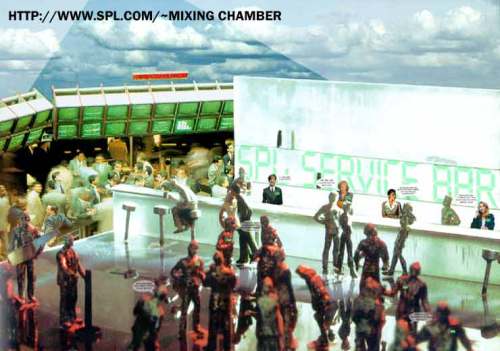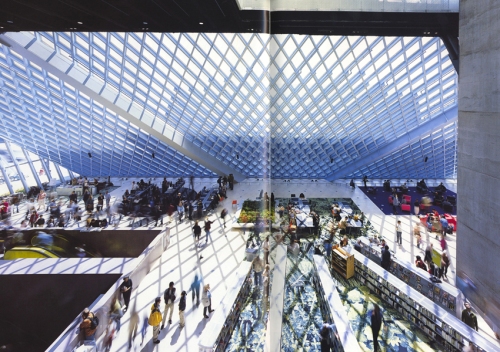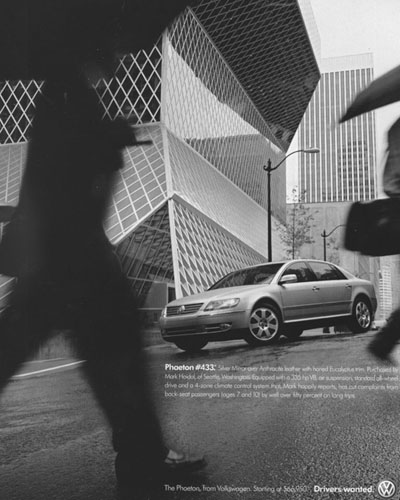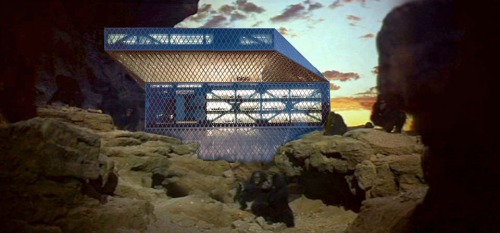This collage depicts the mixing chamber on the 5th floor of the Seattle Central Library, on the top of the floating platform dedicated for meeting rooms. This sort of representations is usually devised not to transmit an actual impression of space, but an intention of experience and atmosphere in a certain space. In this case, we can observe how patrons and librarians interact in a constant flow of interdisciplinary information, creating a stimulating environment of exchange. Upon closer inspection, it is possible to read the dialogues between individuals, which create the basic structure and most important feature of this space, namely social interactions (which can seem odd, given that it is a library). Remarkably this impression is transmitted not only by the serious accumulation of several agents, but also by the creation of small disconnected narratives, which do not follow the traditional linear structure of several different pieces necessarily following one after another to constitute a whole, but the existence of all these parallel (and possibly interconnected) stories create and transmit the notion of diversity and fluidity intended for this space. Interesting analogies to other (familiar) spaces are also embedded in this collage, namely by the positioning of informational screens and bar stools, attempting to translate the innovative idea of a “mixing chamber” by approximation (or hybridization) of other existing spaces.
Posts Tagged 'human figure'
collage: mixing chamber
Published March 10, 2008 Uncategorized Leave a CommentTags: architect, concept book, conceptual, general audience, human figure, interior, photograph, web
photo: personal snap shot
Published March 10, 2008 Uncategorized Leave a CommentTags: discussion, exterior, flickr, general audience, human figure, perspective, photograph, public, web
In this image, the Seattle Central Library is illustrated in a personal photo uploaded on the popular photo sharing website flickr by the user fromform taken during the opening of the library. We can observe the playful interaction between the two friends and the metallic mesh on the 5th avenue entrance of the library. Unlike most common photographic records of this building, here the focus is on the people in the photograph and not on the library, which is relegated to mere scenery. However, by engaging with the façade’s net, they offer a new reading of the building, namely by giving a proper sense of the scale of this massive grid pattern of the façade. In this user’s online photo, as well as those of most other users, the viewer is invited to observe a private moment . This level of personal exposure is now available to everyone, and the boundaries between privacy and publicity become ever more blurred, mostly produced by the new business plan of web2.0 sites where users generate the content. This picture which serves to this specific user as a memento of the time spent at the library with her friend thus becomes another way through which this piece of architecture is mediated and exposed to the larger public.
see fromform’s photographic set of Seattle’s Central Library here
audio tour
Published March 9, 2008 Uncategorized Leave a CommentTags: audio, book spiral, children's corner, distribution, general audience, human figure, interior, mixing chamber, reading room, SPL, tour, web
An 18 minute audio tour of Seattle’s Central Library warmly guided by Diana from the SPL represents the library in this instance. This audio tour was intended to be downloaded by patrons to their mp3 player and used while visiting the library. Despite the listener being guided by the sound, where the narrator frequently gives indications and directions to follow the predefined route, this representation is complemented by the library vertical map available at the entrances of the building on a small scale, and by the actual spaces of the library on a larger scale. Without these other elements, the audio recording loses its meaning. Therefore, we observe in it a resistance to the creation of a single bubble of privatized space inherent to the delivery system of this audio file in personal mobile sound system. This audio track attempts to engage the listener with other people by featuring several “encounters” with librarians on different places, who explain the resources available and the underlying concepts of the spaces. It also aims at engaging the listener with the physical spaces by encouraging the listeners to pause the sound recording and explore the spaces on their own, at their own pace, which is demonstrated by the discrepancy between the actual length of the track -18 minutes- and the expected length of the tour -between 30 and 40 minutes.
flash / quicktime vr: virtual tour
Published March 9, 2008 Uncategorized Leave a CommentTags: 3-D, 5th avenue, architect, book spiral, distribution, exterior, general audience, human figure, interactive, interior, living room, photograph, plan, professional audience, reading room, Rex, section, tour, web

Click on the image to start the shockwave virtual tour conceived by OMA and Rex. To view this tour, you need Shockwave installed on your system and a 3D-capable video card. We recommend a card of 64 MB or more to view the movies in high resolution. A video card with less memory requires a bit more loading time and will result in lower resolution.
This representation can best be described as a virtual tour, which using as basis several photographs taken from the same point but towards different positions are combined together in a three dimensional space by the computer, allowing the viewer to look into all possible directions from a given point. This system attempts to recreate an immersive perception of interior and exterior spaces, enhanced by positional information supplied on the x,y coordinate by the plan and on the z coordinate by the cross section. Furthermore, the viewer has the possibility to move through space (from point to point), reflecting the spatial relationship between these points. Therefore, it is possible to meander through all the public spaces of the library, since the staff floor and the headquarters floor are not represented. Despite the wide coverage of this building by the popular and professional media, or perhaps because of it, photographs of the 2nd and 11th floor spaces are not widely available, and are normally physically not accessible to the public. Similar to Intel’s processors equipped with a Protected Mode, the operating system of this building, where staff meets and controls the library is protected from the users, providing a zone of privacy contrasting to the publicity of other media saturated spaces.
video: music video clip
Published March 8, 2008 Uncategorized Leave a CommentTags: discussion, embodiment, escalator, floor, general audience, human figure, interior, music, narrative, perspective, public, video, web, youtube
Here the Seattle Central Library is the setting for indie-rock band Peaches’s music video. Like the library spaces, the music is also composed of a distinct duality of elements, namely smooth electronica sounds alternated with strong beats combined with the human presence of the vocals. There is a striking proposition in this piece, where the space-time continuity of the action is only allowed in transitory and dynamic spaces like the escalator or the highway, and other static spaces like the meeting room floor, the mixing chamber or the reading are flashed through in rapid succession. Also shown in rapid succession are several different notorious floors of the library, where the presence and stagnation of the human subject is suggested by the immovable image of tennis shoes and trousers while the floors rapidly flicker through. A possible reading to this situation could be, initially, an insinuation to the problematic of the rapid changes of contemporary society to which the human subject must quickly respond and adapt to. The solution seems to lie not in a change of the subject, but in a change of its view, suggested by the zooming out of these views visible in the end of the video.
The video presents another case of a syntagm (narrative) constructed from the paradigm of the SCL. This narrative again emphasizes a singular and subjective point-of-view and an embodied experience of the space. Although we never see his face or hear his voice, we know that our narrator is also our protagonist, as we see, from his point-of-view, his feet, against the various floor textures as he navigates through the space. The soundtrack, the jump cutting, and the reduced frame rate imply a playful, pop-culture subjectivity. Interestingly, but perhaps not surprisingly, the story that unfolds has nothing to do with books, computers, or librarians. It involves a young woman in a beige trench coat whose face we never see, although we – via the protagonist – follow her. This narrative is a romance with an air of mystery or visa-versa, for which the building is but the setting, or perhaps even a secondary character.
photo: interior “urban living room”
Published March 8, 2008 Uncategorized Leave a CommentTags: agent, Bordieu, distribution, el croquis, field, general audience, human figure, interior, perspective, photograph, print, publication
This photo appeared in the architectural journal, El Croquis as part of a mopnograph on Rem Koolhaas/OMA, where an extensive profile of this building is featured. It depicts the “urban living room” on SCL’s 3rd floor.
As you can see, the landscape orientation of the photo, spreading across two pages, focuses on a horizon where the glass skin meets the floor. Shot from a high angle (5th floor) and using an extremely wide-angle lens, as evidenced by the distortion in the foreground, this is an image of the building as landscape. People move through this landscape — their movement is evidenced also by distortion — but they are clearly not the subjects of this image. All of the dramatic diagonal lines lead the eye to a center where there are no people at all.
The dominant visual feature of the images is those diagonal lines, which cover almost the entire image and give the distinct impression of a net, as if a visual metaphor for a network, which is one of the dominant metaphors for society in the information age.
This image could also be said to express Bordieu’s explanation of “the true object of social science” which is not the individual, but the field. In this image, the individuals exist “as agents – not as biological individuals, actors, or subjects – who are socially constructed as active and acting in the field.” The field here being, graphically and dramatically, the library building itself.
There is further evidence of this conception of human individuals as agents in the field that is the building in the conceptual imagery and in the video-lecture by Joshua Prince-Ramus, the architect in charge of construction.
video: sign-language tour
Published March 7, 2008 Uncategorized Leave a CommentTags: discussion, escalator, exterior, general audience, human figure, interior, living room, narrative, perspective, public, reading room, tour, video, web, youtube
This video shows the surprising way the Seattle Central Library can be represented by sign language. Due to the specific nature of the language employed, there is a fragmented conversation between subject and object, as the building and the narrator do not appear simultaneously on screen.
Even though this representation (and sign language itself) uses only the visual medium, it is far from limited. The difference between oral and sign language is comparable to print and digital formats, where one is sequential and linear (print and oral language) and the other has the potential for simultaneous information transmission (digital and sign language). In sign language information can be loaded into several channels and expressed simultaneously, by the specific motion of the hand, body posture and facial expression. This inherent potential of sign language is widely used throughout this tour, as the narrator expresses his views and experiences on the library while guiding the audience through the main public spaces: the living room, the reading room and the long escalator in between.
Following Lev Manovich’s description of a database as both “a structured collection of data” and a collection of “choices from which narrative is constructed” — we can consider the library as the paradigm from which this individual has constructed his personal narrative, his “tour” of the space.
Realizing the innumerable experiential choices that the library presents to any given individual, and also the innumerable choices available in representing an experience of the library with a video camera – it is particularly worth noting that this individual consistently frames himself, not the building, in the foreground and in medium close-up. This narrative’s purpose is not to document the building but to document this fellow’s emphatically embodied experience in and of it.
The personal videos, photos and blog posts, as narratives, stand in stark contrast to the conceptual documents, which concern themselves not with individuals but with operational functions and processes, in which individuals might be supposed to be agents, if supposed at all.
video: SCL dance
Published March 6, 2008 Uncategorized Leave a CommentTags: dance, discussion, general audience, human figure, interior, music, perspective, public, video, web, youtube
This video documents a playful dance by two girls on the meeting room floor of the Seattle Central Library. Either inspired or disoriented by the surreal smooth shapes and the intense color of the fourth floor, the girls appear to enjoy themselves. Their shadowy dancing figures are created by the natural light passing by the netted glassed façade, visible in the distance, and echoed on the glossy floor and walls. The unscripted interaction between the two figures occupies the space in a manner unforeseen by the architect. However haunted by the ever present human user in his design process, the architect can by no means anticipate all the ways a space will be occupied, utilized and appropriated, but can only design for the most frequent uses. Nevertheless, in this instance, the space seems to have inspired these girls to express themselves through a frolicsome dance, tied perfectly to the space by the smooth electronica music which accompanies this video, amplifying the pleasant feeling conveyed by this spontaneous play. This short dance serves as an ephemeral ode to the surprising new building, which houses and reveals a wide amplitude of singular spaces, inviting perfunctory, mechanical functions, but also inspiring surprising new uses.
print advertisement (volkswagen)
Published March 6, 2008 Uncategorized Leave a CommentTags: distribution, exterior, general audience, human figure, perspective, photograph, print, volkswagen
This portrayal of the Seattle Central Library was circulated in the popular print media as an advertisement for a Volkswagen car. Several readings can be made from this image; perhaps one of the most fascinating would entail a discussion of the association of this building’s image to a product (in this case a car) as a means of connoting a certain lifestyle and experience. In this regard it is appropriate to consider that we are not only experiencing a shift from a print-based to a digital-based society, but also from a service economy to what has been coined an experience economy, where the particularity of the experience establishes the difference between otherwise similar products in highly saturated markets. This advertisement illustrates this idea quite cunningly, by minimizing the image of the car, but still framing it between the large human figure in the foreground and the building in the background. This layout leads the viewer’s eye to focus on the car and directly associate it with the original and rule-defiant design of the library, emphasized by the contrast created with the generic office building visible further in the distance. The defiance of preconceptions is extended by the inversion played out in this image, where the human figure appears to be in motion and the vehicle seems to be static.
collage: dawn’s monolith
Published March 6, 2008 Uncategorized Leave a CommentTags: collage, discussion, exterior, general audience, human figure, perspective, photograph, public, web




